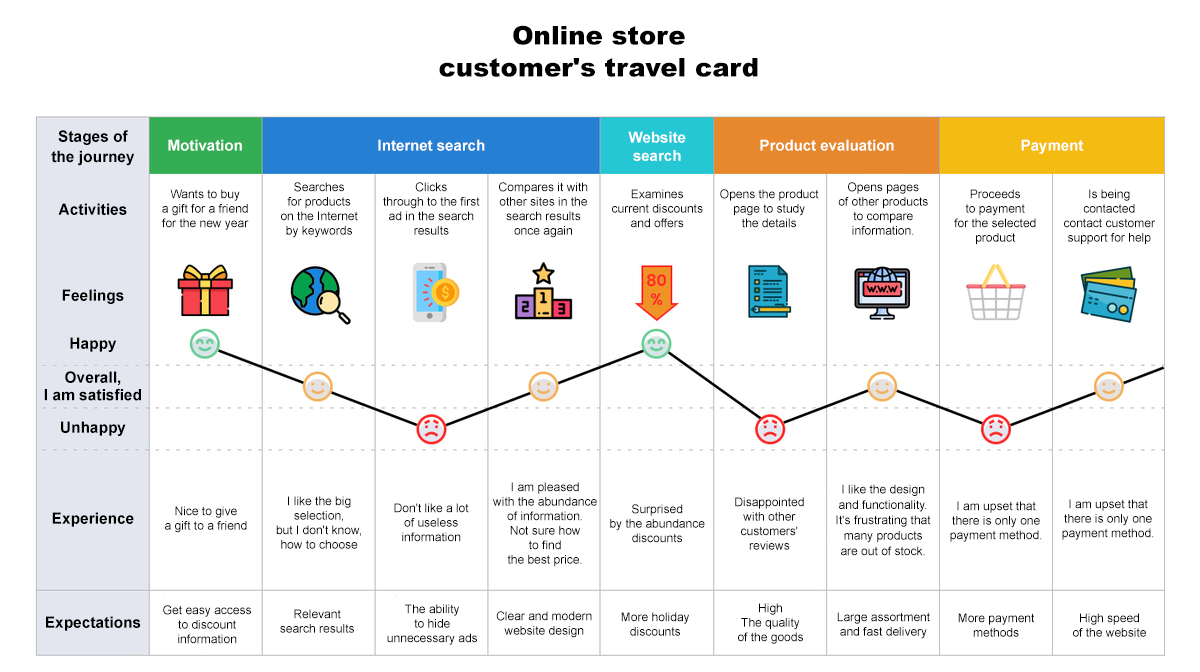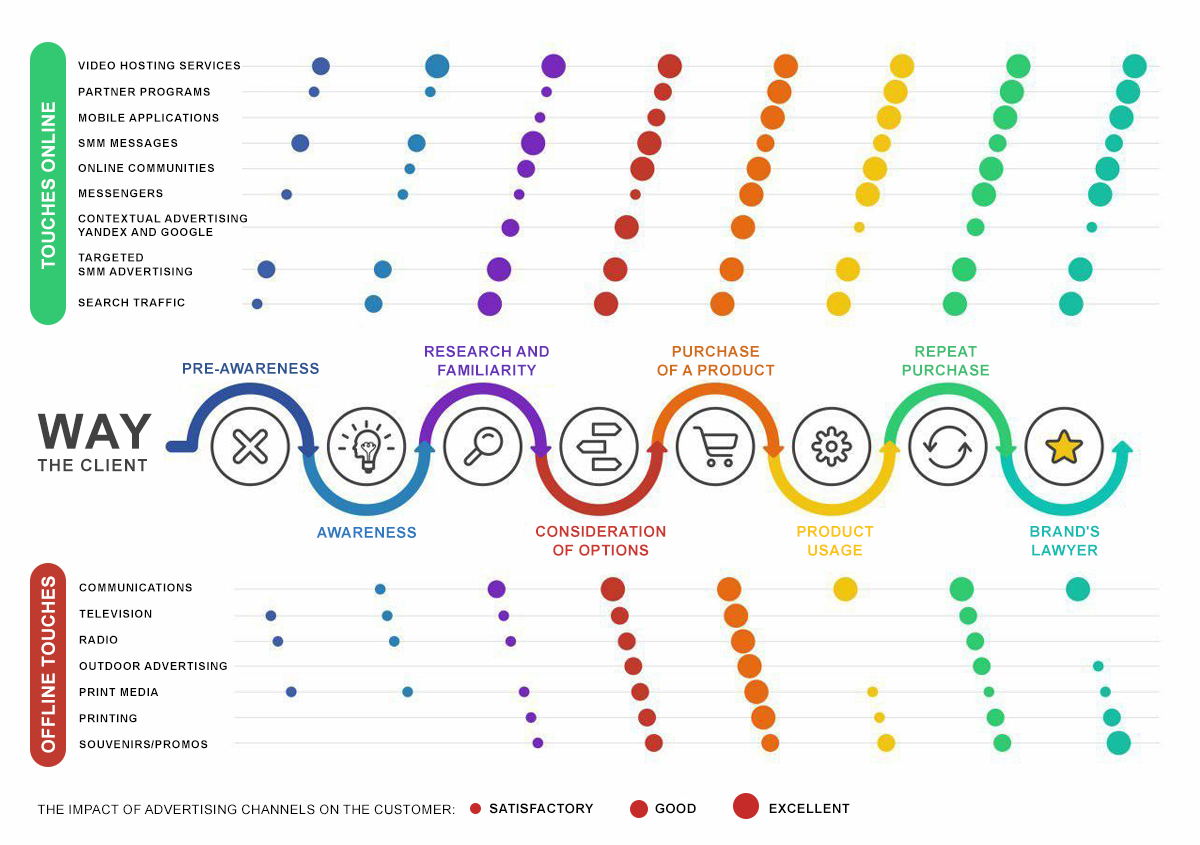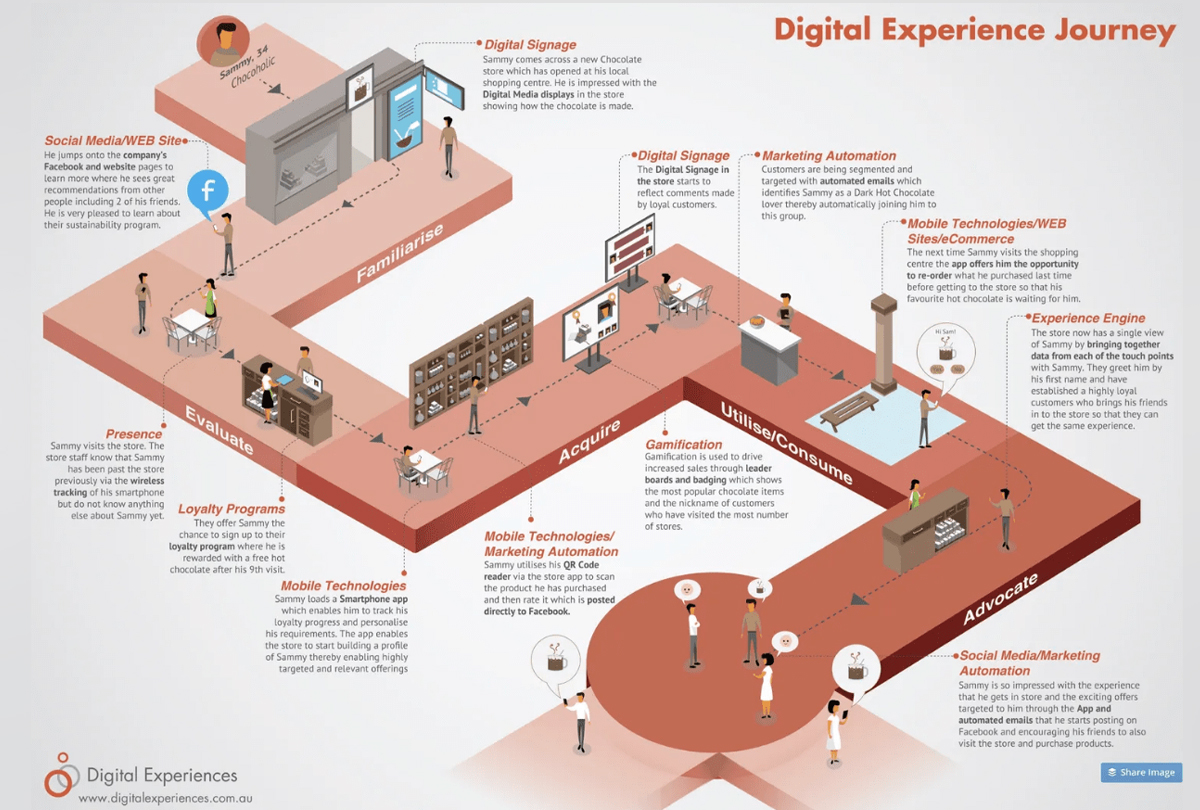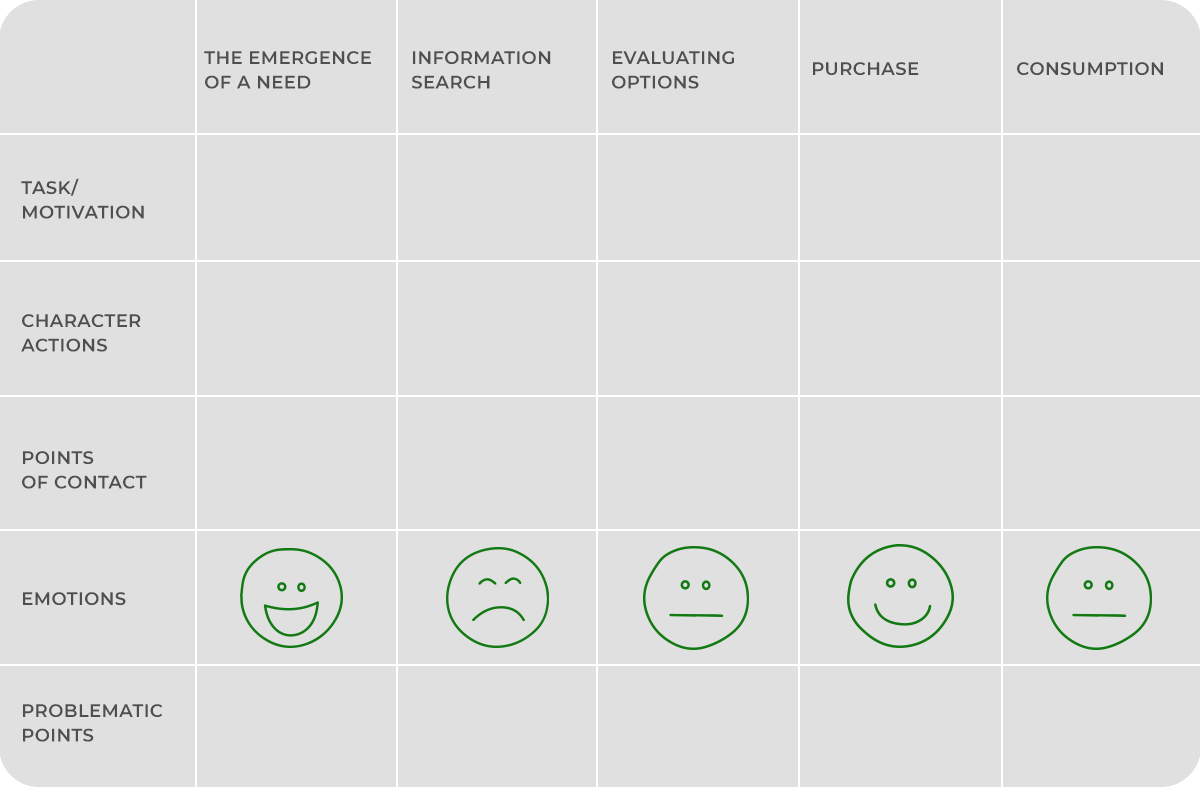Customer journey map (CJM) – what is it and how to build it
Building long-term relationships with customers is not easy. To do this, you need to understand their expectations well and try to eliminate any problems that arise when interacting with the company. The customer journey map tool helps solve these problems.
(1).jpg&w=3840&q=75)
Have you ever thought about the difficulties a client had when they came to your company, what was the decisive moment in their choice, what emotions they got from the purchase? Usually, everything is limited to a sales funnel, but in it we see only the linear movement of the client.
To gain more insight into user experience and visualize data, Customer Journey Map is used in marketing.
Customer Journey Map (CJM) is a map of the user's path that reflects the points of contact with the company, starting from the emergence of a need for a product to purchase and transition to the status of a regular customer.
What does CJM look like?
Most often, CJM looks like a table with graphic elements. The columns indicate the stages of the path, and the rows indicate the necessary information for each stage.

However, maps are not always linear. Some draw diagrams that are difficult to understand for someone not in the know:

Customer journey maps are also available in infographic form.

What blocks does the map consist of?
- Interaction stages are the various phases that a customer goes through when interacting with a product or service. Includes the stages of recognizing a need, researching solutions, getting to know the company's product, studying it, visiting an office or store, etc.
- Touchpoints are specific points of contact between a customer and a brand: visiting a website, viewing an ad, contacting customer support, writing a review, and other important events.
- Interaction channels. Here you need to determine the channels that customers use to interact with the brand: website, social networks, mobile applications, messengers, stores, call centers, and others.
- Emotions — analysis of the client's emotions and feelings at each stage of interaction: joy, disappointment, satisfaction and other emotions that can affect their perception of the brand. Most often, emotions are displayed on the map using emoticons. It is important to understand that the client's feelings at each step depend not only on the company's work, but also on the content of the stage itself.
- Customer needs and expectations at every stage. It is necessary to adapt the product and services to the real needs of customers.
- Characters are typical representatives of the target audience, taking into account their characteristics, socio-demographic parameters, motivations and behavior.
What tasks does CJM solve?
The CJM customer map in marketing is needed to record the customer's actions and problems they encounter, and to help them make a choice faster and order more conveniently.
Here are the main tasks that CJM solves:
Understanding customer experience
- Customer Journey Visualization: CJM allows you to visualize the entire path a customer takes when interacting with your company, from first contact to repeat purchase.
- Touchpoint Identification: Helps identify all the touchpoints where a customer interacts with your brand (website, social media, physical store, phone support, etc.).
- Emotional picture: CJM allows you to understand the emotional state of the client at each stage of interaction, identifying his positive and negative emotions, pains and expectations.
Identifying problem areas
- Finding bottlenecks: CJM helps identify bottlenecks in the customer journey where problems and dissatisfaction arise that can lead to customer loss.
- Identifying barriers: Allows you to identify barriers that prevent the customer from achieving their goal (e.g. difficulty in placing an order, lack of information, poor support, etc.).
- Analysis of the causes of negative emotions: helps to analyze the reasons that cause negative emotions in clients at different stages of interaction.
Improving customer experience
- Touchpoint Optimization: CJM enables you to optimize every touchpoint, making your brand experience more convenient, simpler and more enjoyable.
- Creating a more positive experience: enables you to create a more positive and emotionally engaging customer experience across all stages of interaction.
- Customer satisfaction: helps to better understand customer needs and expectations and offer them more relevant solutions.
Optimizing Marketing Efforts
- Customize Marketing Messages: CJM helps you determine which messages and communication channels are most effective at each touchpoint.
- Conversion Boost: Helps optimize your sales process by increasing conversions at every stage of the funnel.
- Efficient use of resources: Allows you to allocate resources more efficiently by focusing on the touchpoints that have the greatest impact on the customer experience.
- Personalized Communications: CJM helps develop more personalized communications for different audience segments at every stage of their journey.
Improving processes within the company
- Improved cross-department collaboration: CJM helps to better understand the role of each department in shaping the customer experience and improve cross-department collaboration.
- Alignment of internal processes: helps to align the company's internal processes, making them more customer-oriented.
- Ensuring a shared vision: Helps everyone in the company create a shared vision of the customer journey and focus on their needs.
Increased customer loyalty and retention
Customer Retention: Reducing friction and improving user experience helps retain existing customers and reduce churn.
Build brand advocates: Satisfied customers become brand advocates who will recommend your company to others
Stages of creating a customer journey map
To create a CJM, you need to develop a structure that is convenient for you (table, diagram, chart), and then collect data for each of its elements. You can include each of them in the marketing map or some of them - depending on who is studying the customer experience and for what purpose.
1. Collecting information for CJM
It is better to create a CJM with a team of representatives from different departments in order to immediately have maximum information about the customer's path. First, you need to come up with several characters. A character is a collective image of a buyer who has real characteristics.
Example: a woman, thirty-five years old, single, loves dogs, income level is above average, works in an office, wants to buy quality dog food, is willing to overpay for the brand.
You can also create a CJM for b2b characters. For example, store buyers who are primarily focused on the price and quality of goods.
Where can I gather information to create characters?
Use different sources:
- Data from web analytics, questionnaires or classic social surveys. You can also communicate with clients on social networks, promising a nice bonus (a discount or a gift for the next order);
- Knowledge accumulated by the sales or user support department. They interact with customers most often, know their pain points and objections;
online reviews. Do not rush to delete negative reviews about the company. They will help you find growth points and problem areas; - Personal experience. Go through all the stages yourself or with the help of a mystery shopper: from ordering on the website to receiving the goods with a courier;
- Conduct interviews. In this case, you need to talk to potential customers to understand what their path looks like. Interviews are usually taken from three groups:
- customers - those who use the product or have purchased it in the past;
- non-users - those who have not yet dealt with the product or do not even know about it;
- experts - those who know the niche and products of the company and competitors best. For example, for decorative cosmetics, these would be makeup artists, and for wine - sommeliers.
2. Defining the stages of the customer journey
The buyer's journey begins before they come to the store or place an order on the website. Before that, they can browse social networks, read reviews, consult with friends. At each stage, a person has their own goals, expectations, and problems.
You will come up with your own stages for your business, but we will give you general ones:
- information search;
- choice of company;
- studying the website/social networks/online store;
- purchase online or offline;
- delivery, installation, maintenance; subscription to social networks/mailing list, etc.
3. Selecting CJM interaction points
The appearance of a company's website in search results, receiving an email, filling out a form on the website, calling a manager with a question about a product - these are all points of interaction with the company.
It is important that at every stage of the journey the client receives a positive experience: the site opened quickly, the newsletter seemed interesting, the manager was polite and competent.
Don't forget that a customer can interact with a company not only online, but also in the real world. A conversation with a cashier, a flashing outdoor advertisement, an article in a magazine mentioning the company - all of these are offline channels of interaction.
There may be a huge number of points of contact with the company, but it is important to record them all in order to work through each scenario.
4. Finding barriers and critical points in the customer’s journey.
Barriers prevent the user from moving from one interaction point to another. For example, a crooked link is posted in social networks, from which it is impossible to get to the site, or when placing an order it is not possible to choose your city. It is necessary to find such barriers and understand how to overcome them.
If there are several barriers at the point of interaction, it can become critical. This means that the client experiences strong negative emotions and wants to abandon your product or service.
For example, a pizzeria operator missed an order from the website and called the client back only an hour later. During this time, the buyer found another delivery service that already brought the pizza to his home. The barrier is the incompetent work of the operator responsible for the website.
5. Removing barriers in CJM
The ultimate goal of the Customer Journey Map is to remove all barriers so that a person has only a positive experience when interacting with the company.
If the critical point of contact is the website, and the customer can't find the "Buy" button on it, it's worth redesigning. And if the operators are so busy that they can't take orders within 15 minutes, hire a separate person who will be responsible only for the website.
The main thing is to objectively assess the costs of eliminating barriers in the customer journey. If it is too expensive for you and the profit from new orders does not cover the costs, it is better to get rid of the interaction point. For example, post on social networks only the phone number by which you accept orders.
6. Rebuilding CJM
Create a Customer Journey Map regularly. Once barriers are removed, the user's path may change and other touchpoints may need to be improved. Survey new customers and find out at what stage problems arise so you can improve your service.
Important: do not forget to record and take into account the emotions that the client experiences at each stage.
The final marketing map should include:
- portraits of typical customers and their motives when choosing a product;
- their stories and the stages they go through on their way to purchase;
- the emotions and problems they face;
- solutions for every problem or barrier.
For example, this is what a CJM table might look like: 
Tools for building CJM
To draw a user journey map and present it to a client, management or team, you can use different tools:
- Google Sheets or Excel. A tool that doesn’t require paid subscriptions or special skills. Ideal for small and intermediate maps that need to be discussed with the team and finalized.
- Online boards and special services. Among them are Miro, which in Russia is only available for personal accounts, UXPressia, Canvanizer.
- Design programs and editors. If the creation of a CJM requires visualization, for example, icons, logos or a design layout, then you can involve designers who will draw the map in Figma, Adobe Illustrator or Photoshop.
- On a regular whiteboard. In startups and small teams, CJM can be built on an office whiteboard using sticky notes and a marker.
Main
- Customer Journey Map is a tool that visualizes a customer’s interaction with a brand or product at all stages: from getting to know it to making a purchase and after-sales service.
- The customer journey map contains information about the main stages of user interaction with the product, points of contact with the company, channels, emotional experience, needs and expectations. Based on the map, you can create a description of the character - a typical representative of the target audience segment.
- CJM can be built in a regular table, but it is more convenient in specialized services with prepared templates.
- To build a CJM, it is necessary to study the client and the process of their interaction with the company and the product in as much detail as possible, from the emergence of a need to the purchase and subsequent contact with the company. Research, analytics systems and CRM services, interviews with clients and employees who communicate with users, as well as reviews, competitors' cases, etc. will help you get the necessary information.
- The CJM should be used as the basis for developing a plan to improve customer experience, optimize the user path, and develop a promotion strategy.
